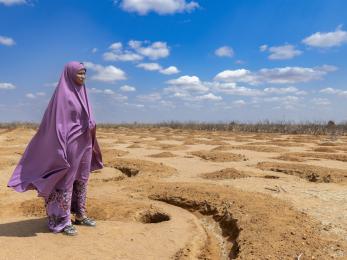Protecting the world from flood risk: Why we invested in Cloud to Street

Mercy Corps Ventures, the venture capital arm of Mercy Corps, invests in startups building climate resilience and financial resilience for communities across the world. We’ve supported 30+ ventures to scale and raise over £70 million in follow-on capital. Read on to learn about the role our ventures play in building a world where everyone can prosper.
This year, scenes of catastrophic flooding in Germany, China, Niger, and the U.S. captured headlines. Climate change is warming the air, allowing it to hold more moisture, which causes more frequent and intense rainfall — and the death, destruction, and damage to supply chains caused by flooding is accelerating. Flooding events like these “had not been seen in perhaps 1,000 years,” which should give us a collective pause; the new and evolving calculus for weather risk will dramatically change our food systems, urban planning, and infrastructure. As climate change accelerates, Swiss Re, a provider of insurance, estimates that global financial losses resulting from floods will account for over £29 billion in damages annually, of which only 30% is insured.
There is a massive insurance gap in emerging markets across the entire spectrum of risks — from protecting an individual Colombian coffee farmer’s crop from drought, and business interruption protection for a multinational supply chain in central Ghana, to sovereign risk insurance that gives a government the financial ability to quickly respond to disasters. Insurance access is a major determinant of economic recovery time and resilience, so solving the insurance gap at all levels is a critical opportunity.
Enter Cloud to Street. Cloud to Street is pairing cutting edge technology with industry-leading science to predict and directly observe floods globally, at scale. This unlocks an entirely new suite of disaster analytics tools for governments and risk transfer products that address the insurance gap. Co-founders Beth Tellman and Bessie Schwarz bring deep expertise in geospatial tech and flood science, and have assembled an outstanding team with backgrounds from Willis Towers Watson, NASA, Google, and others.
We believe that we are entering an inflection point in the insurance space for emerging markets, and that Cloud to Street is optimally positioned. You don’t have to take our word for it. Cloud to Street and their science was featured on the cover of the most recent issue of Nature, which details Cloud to Street’s Global Flood Database, the largest library of flood maps in the world.
Market need
Predicting, monitoring, and assessing the impact of floods is particularly challenging compared to other catastrophic risks. As a result, the most at-risk governments, businesses, and communities are either priced out of insurance policies or simply have no access in the first place. This is due to complexity in the modeling and structuring of flood insurance products, as well as the cost and challenges of determining payouts. Governments in Europe and the U.S. have established a mix of imperfect subsidised approaches to address flood risk, but flood insurance in emerging markets is largely unavailable — the catastrophe risk coverage level is 35% in advanced economies versus only 6% in emerging economies. This is especially alarming considering new estimates of flood exposure being 10 times higher than previously expected, with risk highest in Asia and Sub-Saharan Africa. This means the flood insurance gap is widest for populations most at-risk and least able to weather the economic shocks caused by these catastrophic events.
The Cloud to Street solution
Cloud to Street uses best-in-class flood models and direct observation through satellite data to underwrite parametric flood insurance policies. Traditional flood models take years to build and rely on fragmented, sparse, and expensive data. Cloud to Street’s approach is different. Their data analytics platform is able to predict with great accuracy the size and damage of flood risk, and map floods in high-resolution (down to 30cm) in real time, anywhere on earth, using direct observation (e.g. remote sensing) — at a fraction of the cost. The platform enables insurance policies to be written in markets where traditional data is insufficient for underwriting and payout decisions today. This is particularly crucial for monitoring underserved populations at risk, impaired roads and infrastructure, and property and agricultural damage.
Cloud to Street’s impact is indirect, but potentially catalytic and with dramatic scale potential, already monitoring 122 million people around the world. The company does not directly distribute insurance products at this time, but instead provides cutting edge analytics and modeling that enable other actors to create innovative insurance products (for governments, corporations, and households), quickly respond to the needs of affected households, and/or make strategic decisions that limit future loss of life or property (i.e. urban planning, infrastructure). This last point can’t be understated. Governments, like The Republic of the Congo, have used the company’s flood forecasting to identify floods in days instead of weeks, relocate 7,000 refugees at risk, secure millions in emergency aid, and target relief to over 250,000 people during major emergencies. Moving forward, Cloud to Street could expand to other aspects of the insurance value chain, including origination, distribution, and servicing claims.
“Our mission is to enable all communities to prepare and respond to climate disaster by reducing the barriers to the necessary scientific information and disaster financing. Today some of the most vulnerable governments and the largest insurers are using our global technology to leapfrog old flood data systems to monitor over 300 million climate vulnerable people. The governments have provided emergency services to hundreds of thousands, while the insurers are creating new insurance tools for almost 60m people in the developing world.” ‑Bessie Schwarz, Co-Founder & CEO, Cloud to Street
Investment rationale
We have known and respected the Cloud to Street team for years, tracking their progress as we refined our climate adaptation investment thesis. We are excited to back Cloud to Street at this juncture for four reasons:
Their team
Beth and Bessie are polymaths and exactly the kind of entrepreneurs we like to back. They are magnets for talent, partnerships, and resources. They have worked together for nearly a decade, doggedly pursuing and refining the vision for Cloud to Street. The team continues to add to its roster of rockstars in insurance, geospatial imagery, product development, and hydrology (and they are hiring!).
The market and impact opportunity
The global underinsurance gap is currently £119 billion, of which emerging economies account for 96%. Cloud to Street’s current focus occupies a unique insurance gap at the macroeconomic level, enabling governments to transfer risk and ensure adequate budget to cope and bounce back from a catastrophe. However, their growth path will quickly expand to include a range of risk transfer solutions up and down the flood insurance value chain globally; this is really a blue ocean opportunity. If successful, Cloud to Street could extend insurance to upwards of 30 million previously uninsured people in the coming years, in addition to the 122 million already monitored.
The tech and science
Cloud to Street has been diligent about ensuring its science is world-class and industry leading. Regarded as a thought leader in its field, the team has published over 140 academic papers on remote sensing and flooding. Our diligence included a range of experts from the geospatial imagery, insurance, and risk modeling industries, as well as a number of the company’s existing partners; across the board, they touted the superiority of Cloud to Street’s models and direct observation method.
Their traction
Since expanding into the insurance sector in 2019, Cloud to Street has established commercial relationships and proposals with most of the top reinsurers and insurers in the world. They currently serve over 18 governments, international organisations (including the U.N.), and insurers across 169 countries. Winning over this customer base is an impressive feat.
We are excited to back Cloud to Street, and will put Mercy Corps Ventures full suite of tools and support to action to help them deepen their growth in the insurance market.



